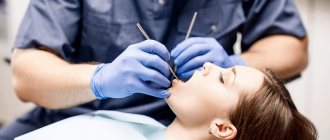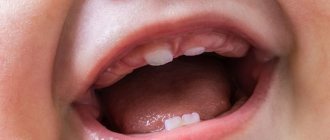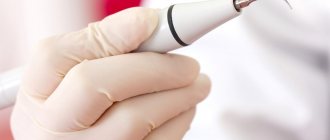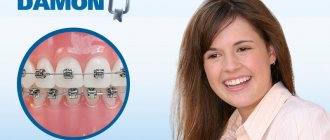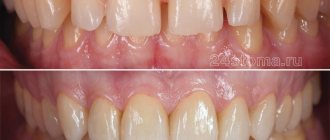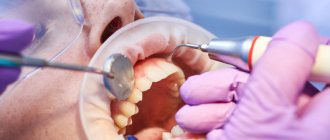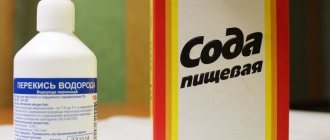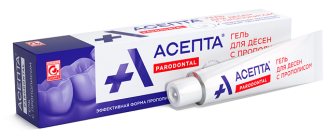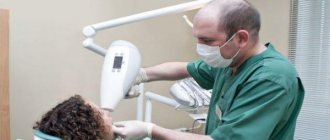Why does tartar form on teeth?
There is always a certain amount of bacteria present in the oral cavity. This is fine. Moreover, bacteria help in digestion by starting the process of decomposition of food already during chewing.
Bacteria are found on the surface of all oral tissues, including teeth. The latter are protected from the harmful effects of microorganisms by enamel. Bacteria cannot penetrate through it.
But, nevertheless, nothing prevents bacteria from accumulating on the surface of the enamel. This biofilm is easily removed with everyday hygiene - brushing, flossing and irrigating. But in some cases - for example, due to untimely removal - the plaque begins to thicken. The reasons for this are:
- Excessive consumption of sweet foods, sugar, foods high in carbohydrates. All this creates a breeding ground for microorganisms;
- Use of low-quality hygiene products, untimely cleaning;
- Smoking. Tobacco smoke destroys the structure of the enamel, forming roughness, cavities and cavities on its surface;
- Irregularity of the dentition, malocclusion;
- Diseases of the digestive system, hereditary predisposition.
Bacterial plaque is easily removed. However, at some point it begins to petrify – that is, to become denser and acquire a mineral structure. And turns into tartar.
Tartar can no longer be removed with everyday hygiene products. It cannot be brushed or flossed off, and even a waterpik cannot destroy it. At the same time, bacteria in this colony continue to destroy both the tooth and the soft tissue located next to it. As a result, itching, swelling, bleeding begins, and increased sensitivity appears.
Treatment of periostitis with physical factors
The complex approach to the treatment of periostitis is complemented by the use of therapeutic physical factors:
- ultra-high-frequency therapy (an electromagnetic field, or UHF, acts as a therapeutic factor in inflammatory processes);
- magnetic applicators (magnetotherapeutic treatment of inflammatory processes);
- medicinal electrophoresis (using an electric current of low voltage and low strength, a medicinal substance is introduced into the body as an additional therapeutic factor);
- helium-neon laser rays (have anti-inflammatory, bactericidal, regenerative effects).
Is it possible to remove tartar at home?
On the Internet and in printed publications you can find many recipes for removing stones yourself at home. This includes a mixture of black radish with lemon juice, decoctions of walnut bark, and other incredibly practical remedies that can be found in any garden.
But the problem is that they practically don't work. Decoctions of herbs and plants can have a positive effect on the soft tissues of the oral cavity, yes. But they won’t be able to cope with mineral deposits. Daily brushing will help remove bacterial biofilm, but not tartar. Attempts to soften mineral plaque with acid, as was done 25-50 years ago, will also not lead to anything good and can cause pain in already inflamed gum tissues and increase the sensitivity of the enamel.
Mineral tartar, unfortunately, cannot be completely removed at home. Not strawberry paste, not a mixture of black radish with lemon, not walnut bark decoctions, not soda, not a swab with hydrogen peroxide. Not a single one, even the most advertised brush or paste, can destroy mineral structures. But scratching, erasing healthy enamel or causing its increased sensitivity is quite possible.
The only effective and safe way to remove mineral plaque (tartar) from the surface of the enamel is to consult a dentist.
Treatment of various types of periostitis
Treatment of serous periostitis
Serous periostitis can occur due to jaw trauma. No special therapy is required to treat serous periostitis. At this stage, it is possible to clean the dental canal and create the opportunity for the independent release of fluid (exudate) during inflammation.
Treatment of acute purulent periostitis
In the case of acute purulent periostitis, the dentist cuts the gum, removes the pus and drains the suppuration. When draining, the tip of a rubber strip (drainage) is inserted into the cavity at the incision site. Drainage prevents the wound from healing too quickly and allows fluid to drain out. It is advisable to remove a diseased tooth, the source of infection of acute periostitis, if:
- severely damaged crown;
- obstruction of root canals;
- lost functionality;
- ineffectiveness of the non-surgical method;
- mobility.
In other cases, it is recommended to eliminate the relevant causes of infection (for example, inflammation of the tonsils and throat), as well as restore the immune system. The most effective approach to the treatment of acute purulent periostitis is complex therapy, combining surgery, drug therapy and physical therapy.
Treatment of diffuse periostitis
Diffuse periostitis is characterized by widespread infection, not limited to a local focus. This is a severe type of disease. As a rule, the patient needs the help of maxillofacial surgeons. In stationary conditions, an operation is performed to remove part of the periosteum or bone. Treatment of diffuse periostitis is complemented by drug therapy and detoxification.
Treatment of chronic periostitis
Chronic periostitis is a sluggish infection typical of patients with impaired immunity. If disease is present, the inflamed area is cleaned and physical therapy is prescribed to reduce symptoms and eliminate infection. In particularly difficult cases, the treatment of chronic periostitis may require serious surgical intervention to completely remove diseased tissue. In addition, with this form of flux, it is important to carry out therapy with vitamins and means to strengthen the immune system. An integrated approach stimulates an increase in the body's immunity.
Professional tartar removal
The most modern, effective and gentle way to remove tartar is ultrasonic cleaning. It is carried out in dental clinics. Hygienists or periodontists specialize in such procedures.
Before performing ultrasonic dental tartar removal, the doctor, guided by the main medical principle “Do no harm!”, assesses the condition of the patient’s oral cavity. Determines whether there are any contraindications. Selects a suitable nozzle for the ultrasonic cleaning device.
During ultrasonic exposure, the structure of the mineral plaque is destroyed. And in most cases this happens from within. Tartar simply falls off the surface of the enamel, falls out of periodontal pockets and interdental spaces.
After this, the enamel is polished. This is necessary in order to prevent the appearance of plaque for a long time. The result is not only noticeable - it is literally tangible. You can run your tongue over the surface of the enamel - it will be clean, smooth and tactilely pleasant.
If tartar has penetrated deep into periodontal pockets or has damaged the integrity of the enamel, causing increased sensitivity, the dentist can also use local anesthesia. This is necessary to make the procedure comfortable and painless for the patient.
What not to do
There is a lot of “harmful” advice that will only worsen the situation. So, what not to do:
- Do not heat. Under no circumstances apply heating pads, scarves, compresses, warming tampons, etc. to a sore tooth.
- Do not apply tablets. You can often come across advice to put an aspirin tablet on a sore tooth, but this can only cause a chemical burn.
- Do not take antibiotics. In the treatment of certain dental diseases, doctors often use antibiotics. But only a specialist can develop an effective and correct regimen for taking them.
How to avoid tartar formation
Tartar prevention is a simple and affordable procedure. It will help protect not only from mineral plaque, but also from other dental diseases. To avoid the appearance of tartar, you must:
- Brush your teeth regularly. Twice a day, morning and evening, 2-3 minutes. You shouldn’t lean on the toothbrush so as not to scratch the enamel, but you shouldn’t move it like a feather either. Select the optimal pressing force;
- Use a variety of oral hygiene products. Flosses will help remove mineral plaque from the interdental spaces, irrigators - from periodontal (gum) pockets, rinses - get rid of harmful microorganisms;
- Use quality home hygiene products. Don’t skimp on toothpaste—dentist services can still cost more than the 50-100 rubles you managed to save;
- Eat 4-6 times a day, but little by little. You should not snack every few tens of minutes, especially snacks like chips, cookies or candy;
- Make it a habit to rinse your mouth with water after every meal. This will help wash away microorganisms, bacterial plaque and food particles;
- Eat more solid, healthy foods. For example, snack on carrots and apples. But you should refuse soft and high-calorie foods (cookies, cakes, etc.);
- Visit your dentist regularly.
These tips will help protect not only from tartar, but also from other dental problems. They will also have a positive effect on the gastrointestinal tract. This means that the rest of the body will say “Thank you.”
Our dental center will not only help you deal with tartar through professional cleaning using modern equipment, but will also teach you proper daily oral hygiene. The procedure will take about an hour, will be painless and calm, and immediately after its completion you will be able to delight those around you with your beautiful, confident and snow-white smile!
First aid for an angina attack
If an angina attack occurs, you must follow the instructions received from your attending physician or (if there were no such instructions) follow the algorithm:
- Note the time of onset of the attack.
- Measure blood pressure, heart rate and pulse.
- Sit (preferably in a chair with armrests) or lie in bed with the head of the bed raised.
- Provide fresh air (free your neck, open a window).
- Take acetylsalicylic acid (aspirin 0.25 g), chew the tablet and swallow.
You should not take acetylsalicylic acid (aspirin) if you are intolerant to it (allergic reactions) and have already taken it that day, as well as if there is a clear exacerbation of gastric and duodenal ulcers.
6. Take 0.5 mg of nitroglycerin. If in the form of a tablet, put it under the tongue and dissolve; if in the form of a capsule, bite it, do not swallow; if in the form of a spray, inhale (inject) one dose under the tongue without inhaling.
If, after taking nitroglycerin, severe weakness, sweating, shortness of breath, or a severe headache appears, then you need to lie down, raise your legs (on a bolster, pillow, etc.), drink one glass of water and then do not take nitroglycerin.
You should not take nitroglycerin if you have low blood pressure, severe weakness, sweating, severe headache, dizziness, acute impairment of vision, speech or coordination of movements.
7. If the pain has completely disappeared and the condition has improved after taking aspirin and 1 dose of nitroglycerin after 5 minutes, limit physical activity and discuss further treatment with your doctor.
8. If the pain persists for more than 10-15 minutes, you must take nitroglycerin a second time and urgently call an ambulance!
ATTENTION ! If aspirin or nitroglycerin is not available and the pain persists for more than 5 minutes, call an ambulance immediately!
9. If pain persists even after taking the second dose of nitroglycerin after 10 minutes, you need to take nitroglycerin a third time. Wait for an ambulance.
What is knee arthrosis?
Knee arthrosis (gonarthrosis, osteoarthrosis) is a progressive disease with destruction of cartilage, pathological changes in the ligaments and peri-cartilaginous bones, and thickening of the joint capsule. The elasticity of cartilage tissue decreases, smooth gliding is disrupted, and bones rub against each other when moving. The joints are destroyed slowly, discomfort is replaced by painful sensations when walking and bending the knees. Acute pain in arthrosis occurs at an advanced stage, when osteophytes (bone growths) formed on the articular surface block movement.
Advantages of visiting Dr. Martin dentistry
The network of dental clinics "Doctor Martin" was awarded the honorary title of dentistry with European quality of treatment. Despite this, the pricing policy is loyal, the cost of the services provided is affordable, discounts and special offers are regularly held (more details on the price list can be found on the website). Every patient is guaranteed free consultations.
To make an appointment with a specialist, you can contact the administrator at the numbers provided or leave a request on the website. At the initial appointment, the doctor will collect an anamnesis, conduct an examination,, if necessary, prescribe a diagnosis and tell you how to save a loose tooth in a particular case. Thanks to the extensive experience and highly qualified specialists, it is possible to cope with even advanced clinical situations. Don't delay, make an appointment right now!

